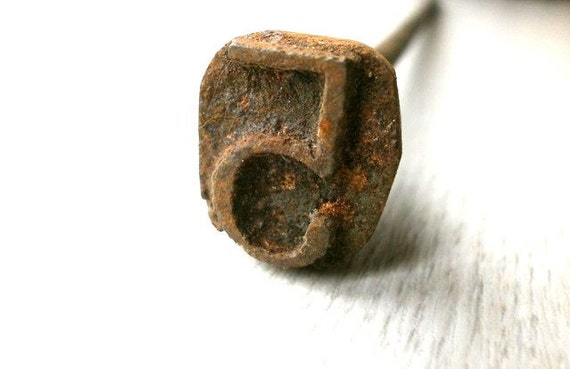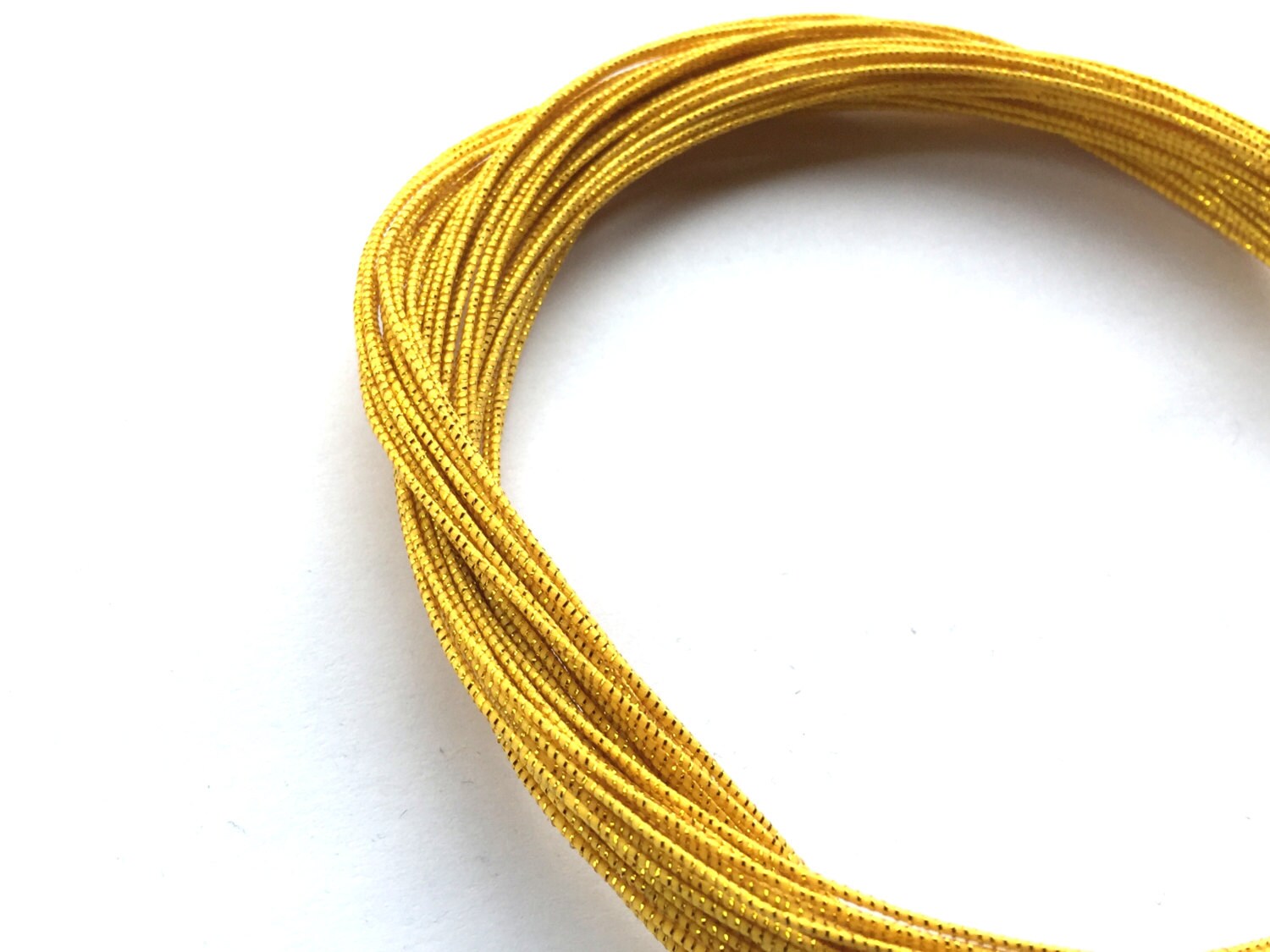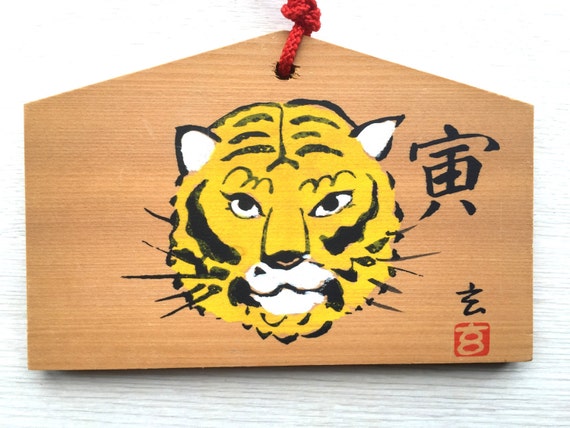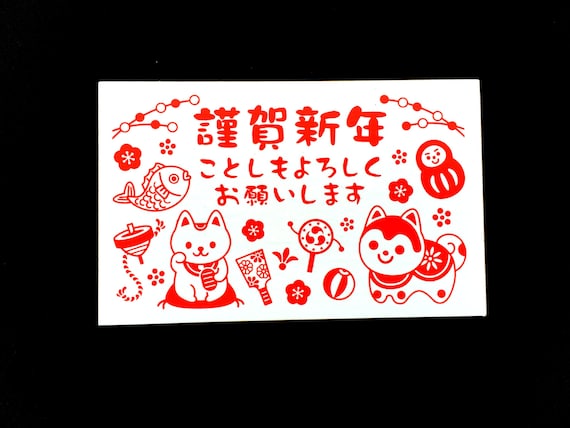 Vintage Japanese Yakiin - Vintage Branding Iron - Number Five - 5 - Metal Stamp - Kanji Stamp - Chinese Character - Japanese Stamp - F184
This is a vintage branding iron called a "yakiin". These were/are used on wood, leather...food...anything you want to brand. Please see the last picture to see an example of how it can be used.
I think they would look fabulous if used in pottery as a stamp. Also...I think they could be used with ink but as it is metal, the image wouldn't be as smooth and clear as a rubber stamp -please keep that in mind if that is how you want to use it.
5 "go" = 5 five.
They are from the "昭和" "showa period" . The "showa" period is from 1926-1989 but these are at least 30 years old.
This is made of iron. Please look at the pictures carefully
It measures 19 cm long x 2 cm (the stamp) wide.
**********************************************************
Our Etsy Stores:
Supplies FromJapanWithLove.etsy.com
Vintage VintageFromJapan.etsy.com
We will combine shipping if you buy from any of our stores.
Vintage Japanese Yakiin - Vintage Branding Iron - Number Five - 5 - Metal Stamp - Kanji Stamp - Chinese Character - Japanese Stamp - F184
This is a vintage branding iron called a "yakiin". These were/are used on wood, leather...food...anything you want to brand. Please see the last picture to see an example of how it can be used.
I think they would look fabulous if used in pottery as a stamp. Also...I think they could be used with ink but as it is metal, the image wouldn't be as smooth and clear as a rubber stamp -please keep that in mind if that is how you want to use it.
5 "go" = 5 five.
They are from the "昭和" "showa period" . The "showa" period is from 1926-1989 but these are at least 30 years old.
This is made of iron. Please look at the pictures carefully
It measures 19 cm long x 2 cm (the stamp) wide.
**********************************************************
Our Etsy Stores:
Supplies FromJapanWithLove.etsy.com
Vintage VintageFromJapan.etsy.com
We will combine shipping if you buy from any of our stores.
 Mizuhiki Japanese Decorative Paper Strings Cords METALLIC Gold And Yellow
Mizuhiki is made from strips of twisted Japanese washi paper. It is very important in Japan and is used to convey warmth and affection. Women use it to decorate their hair and it is used to decorate envelopes and New Year's decorations.
This pack of mizuhiki is a metallic gold and yellow color. There are 15 individual strands. They are each 90 cm or 35.4 inches long.Please remember that these can be cut to the size you want.
This is perfect for scrapbooking, card making or any project you can think of!
Please note that the last picture is just an example of how the mizuhiki can be used-it is not included.
**********************************************************
Our Etsy Shops
For Japanese vintage goods http://vintagefromjapan.etsy.com
For Japanese stickers and more http://fromjapanwithlove.etsy.com
We will combine shipping if you buy from any of our stores.
Mizuhiki Japanese Decorative Paper Strings Cords METALLIC Gold And Yellow
Mizuhiki is made from strips of twisted Japanese washi paper. It is very important in Japan and is used to convey warmth and affection. Women use it to decorate their hair and it is used to decorate envelopes and New Year's decorations.
This pack of mizuhiki is a metallic gold and yellow color. There are 15 individual strands. They are each 90 cm or 35.4 inches long.Please remember that these can be cut to the size you want.
This is perfect for scrapbooking, card making or any project you can think of!
Please note that the last picture is just an example of how the mizuhiki can be used-it is not included.
**********************************************************
Our Etsy Shops
For Japanese vintage goods http://vintagefromjapan.etsy.com
For Japanese stickers and more http://fromjapanwithlove.etsy.com
We will combine shipping if you buy from any of our stores.
 Japanese Temple Wood Plaque - Year of Tiger - Lucky Charm - Yasui Konpiragu - E7-10 - Ema Shrine Plaque
This is an "Ema". "Ema" are small wooden plaques on which Shinto worshippers write their prayers or wishes. The ema are then left hanging up at the shrine, where the kami (spirits or gods) receive them. They bear various pictures, often of animals or other Shinto imagery, and many have the word gan'i (願意), meaning "wish", written along the side. In ancient times people would donate horses to the shrines for good favor, over time this was transferred to a wooden plaque with a picture of a horse, and later still to the various wooden plaques sold today for the same purpose.
Ema are sold for various wishes. Common reasons for buying a plaque are for success in work or on exams, marital bliss, to have children, and health. Some shrines specialize in certain types of these plaques, and the larger shrines may offer more than one. Sales of ema help support the shrine financially.
******** This Ema is from Yasui Konpira Shrine , Japan.
The history of the shrine begins at the time of reign of the 38th Emperor Tenchi (668 to 671 C.E.), when Kamatari Fujiwara established the shrine, to pray for prosperity of the clan and eternal continuation of his descendants. planted purple wisteria and called it Fujidera (The Temple of Wisteria).
The 75th Emperor Sutoku ( reigned 1123-1141) who was especially fond of this wisteria, repaired the temple buildings in 1146 and had his favorite consort Awa no Naishi live there.
The retired emperor Sutoku was defeated during the Hogen Rebellion (1156) and passed away in the land of Sanuki (present day Kagawa Prefecture). His consort Awa no Naishi worshipped in the Kannon Hall of the temple the portrait, drawn in his own hand, that she had received from the emperor.
In 1177, when a Buddhist priest Daien stayed in the temple, the emperor Sutoku appeared before him, showing him a vision of the prosperity of ancient times. This event was immediately reported to the monk-emperor Goshirakawa and the Kanshōji, that was built by his imperial order, is said to be the origin of our shrine.
The temple Kōmyōin Kanshōji was devastated by fire spread by armies during the Ōnin Rebellion (1467-1477). However in 1695, the Rengekōin, originally located at Uzumasa Yasui (Ukyo Ward of Kyoto City) was moved to the present site. As shrine deities, alonside the emperor Sutoku, Ōmononushi no Kami (transferred from Konpira Shrine in the land of Sanuki) and prince Yorimasa Minamoto were enshrined here. The shrine then became known as “Yasui Konpiragu”.
After the Meiji Restoration (1868) the name Rengekōin was abandoned and the name of the shrine was changed first to “ Yasui Jinja” and later to “ Yasui Konpiragu” by which it is known today.
For more information and great pictures please see
http://www.greenshinto.com/wp/2013/10/15/yasui-konpira-festival/
http://thekyotoproject.org/english/yasui-shrine/
It measures 14.5cm x 9.5 cmx 8mm.
Japanese Temple Wood Plaque - Year of Tiger - Lucky Charm - Yasui Konpiragu - E7-10 - Ema Shrine Plaque
This is an "Ema". "Ema" are small wooden plaques on which Shinto worshippers write their prayers or wishes. The ema are then left hanging up at the shrine, where the kami (spirits or gods) receive them. They bear various pictures, often of animals or other Shinto imagery, and many have the word gan'i (願意), meaning "wish", written along the side. In ancient times people would donate horses to the shrines for good favor, over time this was transferred to a wooden plaque with a picture of a horse, and later still to the various wooden plaques sold today for the same purpose.
Ema are sold for various wishes. Common reasons for buying a plaque are for success in work or on exams, marital bliss, to have children, and health. Some shrines specialize in certain types of these plaques, and the larger shrines may offer more than one. Sales of ema help support the shrine financially.
******** This Ema is from Yasui Konpira Shrine , Japan.
The history of the shrine begins at the time of reign of the 38th Emperor Tenchi (668 to 671 C.E.), when Kamatari Fujiwara established the shrine, to pray for prosperity of the clan and eternal continuation of his descendants. planted purple wisteria and called it Fujidera (The Temple of Wisteria).
The 75th Emperor Sutoku ( reigned 1123-1141) who was especially fond of this wisteria, repaired the temple buildings in 1146 and had his favorite consort Awa no Naishi live there.
The retired emperor Sutoku was defeated during the Hogen Rebellion (1156) and passed away in the land of Sanuki (present day Kagawa Prefecture). His consort Awa no Naishi worshipped in the Kannon Hall of the temple the portrait, drawn in his own hand, that she had received from the emperor.
In 1177, when a Buddhist priest Daien stayed in the temple, the emperor Sutoku appeared before him, showing him a vision of the prosperity of ancient times. This event was immediately reported to the monk-emperor Goshirakawa and the Kanshōji, that was built by his imperial order, is said to be the origin of our shrine.
The temple Kōmyōin Kanshōji was devastated by fire spread by armies during the Ōnin Rebellion (1467-1477). However in 1695, the Rengekōin, originally located at Uzumasa Yasui (Ukyo Ward of Kyoto City) was moved to the present site. As shrine deities, alonside the emperor Sutoku, Ōmononushi no Kami (transferred from Konpira Shrine in the land of Sanuki) and prince Yorimasa Minamoto were enshrined here. The shrine then became known as “Yasui Konpiragu”.
After the Meiji Restoration (1868) the name Rengekōin was abandoned and the name of the shrine was changed first to “ Yasui Jinja” and later to “ Yasui Konpiragu” by which it is known today.
For more information and great pictures please see
http://www.greenshinto.com/wp/2013/10/15/yasui-konpira-festival/
http://thekyotoproject.org/english/yasui-shrine/
It measures 14.5cm x 9.5 cmx 8mm.
 Lucky Cat Stickers - Japanese Washi Stickers - Traditional Japanese Stickers - Japanese Food Stickers - New Year Stickers S148
This is a beautiful sheet of Japanese washi stickers. There are many traditional Japanese New Year items like lucky cats, food, pine, lucky fish, plum blossoms, fans, games, bamboo, dharma dolls, treasure boat and much more! Many have gold which adds a touch of elegance!
*****These were so hard to take pictures of. I promise you they look amazing in person!
Our Etsy Shops
For Japanese vintage goods http://vintagefromjapan.etsy.com
For Japanese stickers, fabric, and more http://fromjapanwithlove.etsy.com
Lucky Cat Stickers - Japanese Washi Stickers - Traditional Japanese Stickers - Japanese Food Stickers - New Year Stickers S148
This is a beautiful sheet of Japanese washi stickers. There are many traditional Japanese New Year items like lucky cats, food, pine, lucky fish, plum blossoms, fans, games, bamboo, dharma dolls, treasure boat and much more! Many have gold which adds a touch of elegance!
*****These were so hard to take pictures of. I promise you they look amazing in person!
Our Etsy Shops
For Japanese vintage goods http://vintagefromjapan.etsy.com
For Japanese stickers, fabric, and more http://fromjapanwithlove.etsy.com







